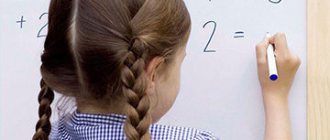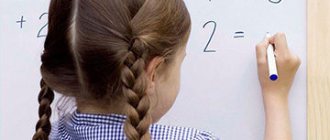Child development is a consistent and time-consuming task for parents. Intellectual and psychological development in children occurs very quickly, and the desire to learn new things is limitless. Therefore, amazing results can be achieved in the education of children. However, the question of how to learn numbers with a child is still difficult for parents. We subconsciously put off studying because we ourselves don’t like to count. But memorizing numbers should be a fun and exciting process for a child. The correct technique will help arouse the child’s interest and increase the effectiveness of learning. To do this, it is important to find out why it is difficult for children to remember numbers? They often seem similar to each other to preschoolers. Another reason may be that the child does not understand the information being studied. Therefore, you need to teach numbers to a preschooler gradually, without pressure. You shouldn’t study several numbers at once; it’s better to start one at a time. Learning numbers is not difficult, since memorizing numbers occurs during play using colorful pictures, bright visual images, and favorite toys.
Study plan
A preschooler can successfully learn letters and numbers. But for now, for him, these are just icons and incomprehensible hooks. The main thing is that parents’ interest in the result, their conscious desire and abilities turn mathematics lessons into an exciting journey into the world of knowledge. So how can you learn numbers with your child quickly and easily? To help you solve this problem, we suggest following a number learning plan:
- Encourage your baby to put away the right amount of toys or other items. The selected items must be placed in a row to make it easier for the child to count them.
- Explain to your child which number corresponds to the number of objects.
- Study the number with your child. Talk and find out what each number looks like. If in the future it will be difficult for a preschooler to immediately name a number, he will be able to remember it by association. Many people have very developed associative thinking. This fact formed the basis of mnemonics - the science of quick memorization.
- Do the exercise several times. This method will help you understand the relationship between a number and the number that represents it. The exercise develops several types of memory: visual, motor, muscle.
- In the future, talk to your child about this and other numbers until he can confidently name them.
- Draw the numbers together, sculpt them from plasticine and name them at every opportunity. They will become friends for the baby, and then he will remember them.
You need to accustom your child to numbers little by little when he is interested in them. There is no point in studying them earlier. Rushing through learning can ruin a child's interest in math. Study space also plays an important role. There should be no tablets, cartoons or distractions nearby. This will help the child focus on learning new material. Don't forget about good lighting, satisfied appetite and small bonuses for success.
Educational games
We all intuitively know how to learn numbers with a child quickly and easily: the main activity for children is play.
With its help, preschoolers master new information and consolidate it. Math games will help children become familiar with quantity, numbers and learn to count. They also help develop speech, attention, memory, and thinking. Activities with your child need to be made more difficult gradually. During the learning process, you should remain calm, even if the child does not immediately remember the numbers. We recommend praising your child for all small successes and victories. This will help maintain interest in learning. To study numbers, you can choose a fun game activity that is appropriate for the child’s age. How to teach a child numbers?
Here are educational games for children with numbers:
- “Match the number with the picture.” In the figure you need to find a number that corresponds to the number of objects. You can print or draw such drawings for free, you don’t even have to buy them.
- "Draw the numbers." Parents can read the description of the number, and the baby must guess what number we are talking about and draw it.
- "Funny numbers." The child tries to recognize numbers in interesting drawings, where the number is disguised with a funny plot. Here mom can be creative and draw her own drawings.
- "Talking Numbers" Choose or come up with several descriptions of numbers so that the child can guess what we are talking about. For example: the traffic light will tell you what number I have. Or “bad grade for students.”
- "The same number". For example, you can take cups and corresponding saucers (you can deliberately skip one so that the baby can correct you). Ask your child to find a pair for each circle and count the number of pairs.
- “Draw the numbers on the back.” The parent draws a number on the child's back. The baby's task is to guess. Then you can change places.
- "Find the missing number." Write the numbers from 1 to 10. Deliberately leave one out. The child must determine the missing number. This game exercise is great for training attention.
- "Confusion". During the game, we consolidate our knowledge of numbers, counting from 0 to 10 in forward and reverse order, and also develop attention and memory. We put the numbers in order, then the baby turns away, and the adult mixes them up. The child’s task is to understand and correct the mistake.
In the world around you, you and your child can count everything you see. For example, birds, cars, children, cats and dogs. With a little imagination, learning to count will turn into an exciting activity for your child. Systematic repetition of game exercises will help your child quickly learn to count and memorize numbers. It is important to celebrate his successes and rejoice in victories, even if they are not very significant yet. By the way, at the same time you can do another important thing - learning the alphabet.
Mathematics for kids. Basic principles
The math games that I want to talk about in this article are best suited for children 2-4 years old (and some even earlier). The main goal of these games is to teach the child to visually recognize a number, to understand which is larger, which is smaller, which are the same, which quantity corresponds to each number, and what will happen if you add one more to three apples. I would like to note that these are games, not lessons. Children at this age will not like it too much if you constantly torture them with questions like “Show me the number 3” “Tell me how many sticks are there?” They need to be interested by unobtrusively adding math problems to everyday story games. I notice the highest interest in my daughter when her favorite toy personally tells her about her problem and asks her for help (I’m talking about the toy, of course).
Don't try to play with big numbers right away! It is enough to limit yourself to 4-5 games. Agree, it is much more attractive to help a child master various operations with numbers not exceeding the number 4 and develop mathematical thinking than to simply learn to count to ten without knowing how to operate with each of these numbers. A child who has mastered operations with small numbers will then easily transfer his skills to large numbers.
So, math games for kids:
Exercises
All parents know how difficult it is to teach a child numbers. To make learning easier, we recommend visualizing the information. There are several options on how to do this:
- Prepare large pictures with numbers. You can invite your child to paint it with bright colors;
- Another option is to depict the figures and the number of elements that correspond to the desired number;
- Look for familiar numbers for your baby in everyday life. On the street, in the store, at home.
- Ask your child to help you count the goods in the cart or the birds on the tree (“otherwise I can’t see”). This helps him understand why all this math is needed. In addition, he feels important and gets motivated to continue studying.
- Ask your child to take exactly three cookies from the pack and give you exactly two bananas. This will also be a great workout for your baby.
These useful habits will help you learn numbers with your child quickly and easily, which allow you to appreciate the significance of these activities.
Classes
Often parents, when starting to teach their child mathematics, mainly pay attention to ordinal counting or memorizing numbers.
Learning quantities rather than numbers can help your child learn to count quickly. And also understand the meaning of the material studied. For a child, the concept of “five candies” should not be just words; the child needs to understand how much it is. So you need to figure out how to teach your child numbers and do it with specific examples? There are interesting tasks for children to learn numbers, here are some of them:
- Board games. Various games with cubes and counters are a well-known method for teaching ordinal counting with preschoolers. By regularly reading the symbols on the cube, the child remembers the number and understands the relationship with the number of objects. Taking a step in the game, he understands that it is not two or three steps.
- Personal information. Information about the preschooler himself can help him remember numbers. For example, you can associate numbers with the child’s age, apartment or house number. Everything that surrounds your baby will help you learn numbers. Let his relatives ask him where he lives? What is the apartment number? Correct answers will help your child get pleasant emotions and consolidate the acquired knowledge.
- Art Gallery. You can create an art gallery with your child. And the pictures will contain images of numbers. Let the child choose what he likes best.
There are several options for creating paintings:
- Representation of numbers with paints, pencils;
- Using plasticine and glitter;
- Cutting numbers from cardboard or paper;
- Application;
- Laying out numbers from available materials, such as pasta or beans.
When the child becomes familiar with the next figure and does the necessary exercises, it is worth consolidating the new information.
Together with your child, look for familiar numbers on various objects - on the pages of fairy tales, on advertising signs, in images in books, and so on. If it is difficult for a child to learn new material, you need to additionally do similar exercises with him. Now you know how to learn numbers with your child. But keep in mind that a difficult topic must be repeated after some time. Classes with children on teaching numbers should be carried out consistently and regularly. Information is studied from simple to complex. You should not move forward until the previous material has not been fully mastered. The previous material is the basis for studying new topics. Only regular lessons with children on teaching numbers will lead to success. And if things get hot, you can turn your attention to studying the multiplication tables.
Repeating numbers
To reinforce numbers, games will be useful in which the child needs to find identical numbers and combine them. For example, you can match houses to toys by numbers, place cars in numbered garages, etc.
Or play the math game "Train Engine" . To do this, draw a steam locomotive on paper or build a steam locomotive from a construction set, numbering the cars. Each passenger, as they approach, will call out the number of their carriage, and let the child seat everyone in their seats.
Books with poems about numbers, like Marshak’s “Merry Counting” (Ozon, Labyrinth, My-shop), will also help in memorizing numbers. We were lucky and the numbers in the book were exactly the size of our soft numbers, so we overlapped them as we read.
I also really like “Merry Count” by N. Vladimirova (Ozon, Labyrinth, My-shop), I wrote about it here before.
How to teach a child to write numbers?
It is worth teaching a child to write numbers after mastering mental counting. The child’s psychological attitude plays an important role in the learning process. It is impossible to avoid whims if the child does not want to study or does not understand the meaning of new information. You should also take into account the duration of classes, because a baby gets tired much faster than an adult. Psychologists do not recommend forcing a preschooler to complete a task until it succeeds. If the child is tired, you need to postpone the exercise for a while and switch to other activities. In order for your child to enjoy learning numbers, you need to interest him. Eliminate repetitive tasks. There are several teaching methods:
- Writing numbers by dots.
- Mathematical recipes.
- Counting sticks.
- Counting with objects.
- Application of the Montessori method.
Using various techniques will help your child maintain interest in learning numbers for a long time.
A variety of visual information and playful forms will help your child quickly master counting and recognize numbers. When studying numbers with a preschooler, you need to break them down into elements. The child will quickly understand and remember the algorithm for writing them. When teaching this technique to a preschooler, explain important points.
Your child needs the following skills to successfully learn to write numbers:
- A preschooler should easily navigate the notebook sheet.
- The baby must know the right and left sides, the upper and lower boundaries of the cage.
- The child understands where the boundaries of the cell are.
- Visually, you can divide the cell into four squares.
- Can write with slant.
When a child masters the listed skills, he will be able to perform more complex exercises - learn to write numbers. Here are some other important aspects for preparing your child for school, don’t miss them. Now the requirements for first-graders are very strict.
Simple operations with objects: addition and subtraction
No, of course, I won’t write here that it’s time to solve the examples. We will simply unobtrusively, during the game, give the child an elementary and very simplified idea of such mathematical operations as addition and subtraction. Everything is just in a playful way! If the child finds it difficult or does not want to count, we simply pronounce the conclusion from the game situation ourselves : “There were three candies, we ate one, there are two left.” Here are some examples of games with which you can train your child’s mathematical thinking (let me remind you that so far we only use the smallest numbers in our games - within 4-5):
- We take some toy and go with it into the forest in search of berries. For example, we played with a cat. Walking around the room, we found berries and pebbles of two colors under chairs and tables. Well, at the end they counted: “How many orange berries did the cat find? Three. How many yellow ones? Two. Now let's count how many berries he found. Five. It turns out that we collected 2 yellow berries and 3 orange ones, for a total of 5!”
- The fixies gathered to repair the chair. They have 3 bolts. Let's calculate whether each fixie has enough bolts. How many more bolts do I need to find?
- We transport the cubes in the car to the construction site (let's say 3 pieces). During transportation, one cube falls out. We count how many cubes are left.
- We give the bear three candies, he eats two. We count how much he has left.
- It is very interesting to play the so-called “hide and seek” game. For example, we draw four apples, then cover one with our palm, how many are left? Then we close two, etc.
Selection of mathematical copybooks
It is best to use printed materials to teach your child how to write numbers correctly. You can print the math workbook yourself or purchase it at any bookstore. It is necessary to take into account that they come in different types and are designed for a certain age. You should not force materials on your child that are not appropriate for his age and level of training. He won’t become smarter, but he will definitely hate studying.
- At the age of 3-4 years, we recommend using copybooks with funny numbers. Fascinating illustrations can interest a child.
- At 4-5 years old, you can use didactic materials with figures. They will help train your child's hand.
- At the age of 5-7, we suggest that you use copybooks that contain an example of writing a number. For independent learning, a dotted outline is presented that the child can easily repeat. It is worth paying attention to didactic materials that contain additional tasks for hand training.
After the age of five, a preschooler begins to write numbers according to all the rules.
The child masters practical skills gradually. If you exclude any stage, working with copybooks will not be easy. Due to a lack of understanding of how to perform a particular exercise and poor finger coordination, a young student can be anxious and moody. The main task of parents is to be calm and not irritated if they need to return to the initial stage of learning. An easier task—reading—will help diversify your math classes and relieve stress. Find out how many words a child should be able to read in a minute in first grade. Classes should be conducted in a friendly and positive atmosphere. Imagine with your child and come up with interesting tasks. Then new knowledge will cause him only positive emotions, and the child will be able to feel confident at school!
Author: Rita Borzenkova











